Red frogs and toads of the world are common in tropical forests, temperate climates, and even deserts.
Highly colorful, red frogs and toads may come in different morphs and may even be avoided by predators due to their potentially poisonous appearance.
Table of Contents
Are Red Frogs Poisonous
Red frogs are highly poisonous. Some studies suggest red frogs are generally more poisonous than green frogs.
While exceptions apply, many types of red toads and frogs of the world are poisonous to animals and humans.
They absorb toxins through their diet. Ants, termites, and bug toxins are absorbed by these frogs and toads which can be lethal to some animals and toxic to humans.
Skin secretions of these frogs and toads allow them to keep potentially deadly bacteria away.
Sticky skin secretions also allow them to be unpalatable to predators.
Red frogs and toads can also cause mild to severe allergic-like reactions when handled.
Often patterned and contrasting in appearance, red frogs and toads are also common in captivity. They may not be as poisonous in captivity based on the foods they are fed.
Some of the most poisonous red frogs only grow to a size of 1 inch and are found in moist forests of the world.
Types of Red Frogs and Toads
Some of the best-known red frogs and toads of the world can be categorized as follows.
1. Pacman Frogs

Native to South America, Pacman Frogs are named after the famous Pac-Man video game. These types of horned frogs come in different colors.
8 subspecies of these frogs exist around the world.
The Strawberry Morph Pacman Frog is one of the red frogs of this group, together with the Surinam Horned Frog.
These types of frogs grow to a maximum size between 5 and 7 inches.
While not poisonous, these types of frogs may be aggressive. Their large mouths and sharp teeth are some of the reasons these types of frogs shouldn’t be handled.
Red nuance – pale red
2. Madagascar Tomato Frog

Varying shades of red are specific to The Madagascar Tomato Frog (Dyscophus antongilii). This is a species that has slightly different red nuances between males and females.
The female has a slightly darker nuance of orange-red.
Further physical distinctions are seen in these frogs in their patterns. While some Madagascar Tomato Frogs are pattern-free, others have black spots or stripes along the sides.
Apart from being a species perceived as dangerous through coloring, Madagascar Tomato Frogs cause skin-level reactions in humans.
More adverse reactions are seen in animals such as dogs and pets licking or eating the frog which secretes a sticky substance from its skin.
Red nuance – bright orange-red, dark orange-red
3. Strawberry Poison Dart Frog

A species of Southern Central America, Strawberry Poison Dart Frogs (Oophaga pumilio) comes in different shades of red.
This is a frog often seen in an orange-red morph with or without black spots on the dorsum.
Another highly common morph of the Strawberry Poison Dart Frog in captivity is the Blue Jean variant.
This frog is still orange-red but has blue legs that resemble blue jeans.
Tens of Strawberry Poison Dar Frog morphs exist around the world. This is a species that becomes toxic or highly toxic.
It’s here that it absorbs the toxins from its food, such as ants.
Red nuance – orange-red
4. Granular Poison Frog

A species of Central American tropical forests, Granular Poison Frogs (Oophaga granulifera) are multicolored species with a red-dominant nuance.
The head and upper body of these frogs are bright red with a specific granular skin texture.
Frogs of the species further show either olive or blue ventral coloring and rear leg coloring.
A species found across the forest of Panama, Granular Poison Frogs are poisonous and aggressive.
Males of the species show aggression through the release of skin-level chemicals as well as through calling signals which they rely on to maintain their territories.
Granular Poison Frogs are small as they only reach a maximum size of 0.8 inches.
Red nuance – bright red
5. Verreaux’s Tree Frog

Growing to a size of up to 1.3 inches, Verreaux’S Tree Frogs (Litoria verreauxii) come in different colors, including a brown-red morph.
A species of South Queensland in Australia, these types of frogs are highly variable in coloring.
While its red-brown dorsal morph is less variable, this is a species that comes in various shades of green and gray with or without dorsal patterns.
These frogs are further known for their rare whistling-like calls, which makes them a distinct species in forests and wet areas.
Calls of the species are heard in the spring and summer months, the period in which the frog breeds.
It can be heard next to bodies of water as female Verreaux’s Tree Frogs lay eggs in water.
Red nuance – brown-red
6. Red-backed Poison Frog
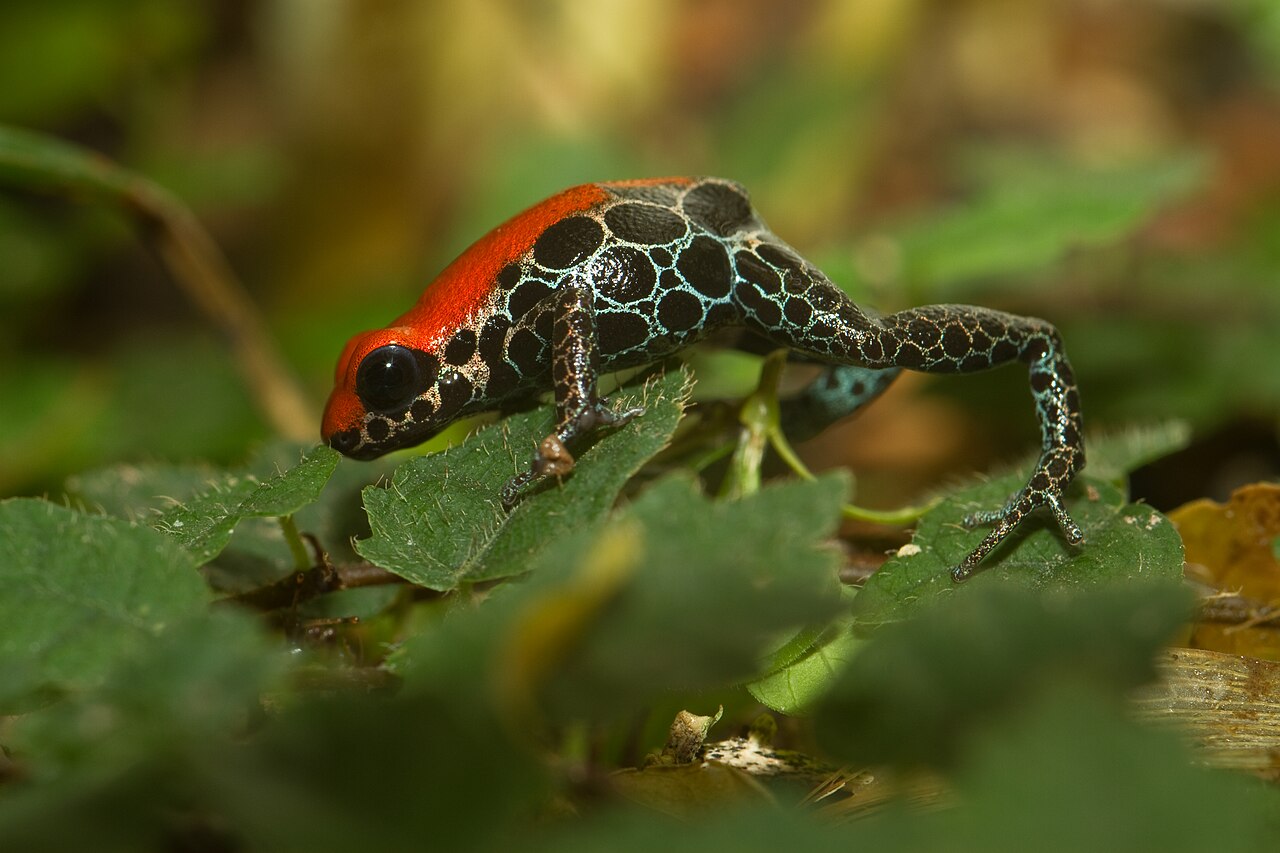
A South American species, The Red-backed Poison Frog (Ranitomeya reticulata) is a species named after the vivid red appearance of its dorsum.
This is a species with a bright red warning dorsal color and black spots on the sides, and legs.
Its black dots are separated by blue, gray, or brown patterns that resemble a mesh pattern.
Red-backed Poison Frogs are poisonous to humans and animals.
These types of frogs are only poisonous in their natural environment, however. Their poison comes from the toxins these frogs absorb through food.
Ants and bugs are some of the typical species that the frog eats for toxin absorption.
Red nuance – bright red
7. Pearly Tree Frog

A species only found in Indonesia after it was believed to be extinct, Pearly Tree Frogs (Nyctixalus margaritifer) come in multiple colors.
One of its common variants is an orange-red nuance which allows this species to stand out.
The dorsal sides of the species may show white or cream spots, particularly along the sides of the body.
Some of the rare morphs of the species also show green spots on an orange-red or red-brown main body color.
While it can easily be spotted in its forested habitat, these frogs live far from humans as they only inhabit wet woodlands above 2.300 feet.
A high-elevation habitat means this species may only be seen in captivity.
Red nuance – orange-red
8. Burmese Squat Frog
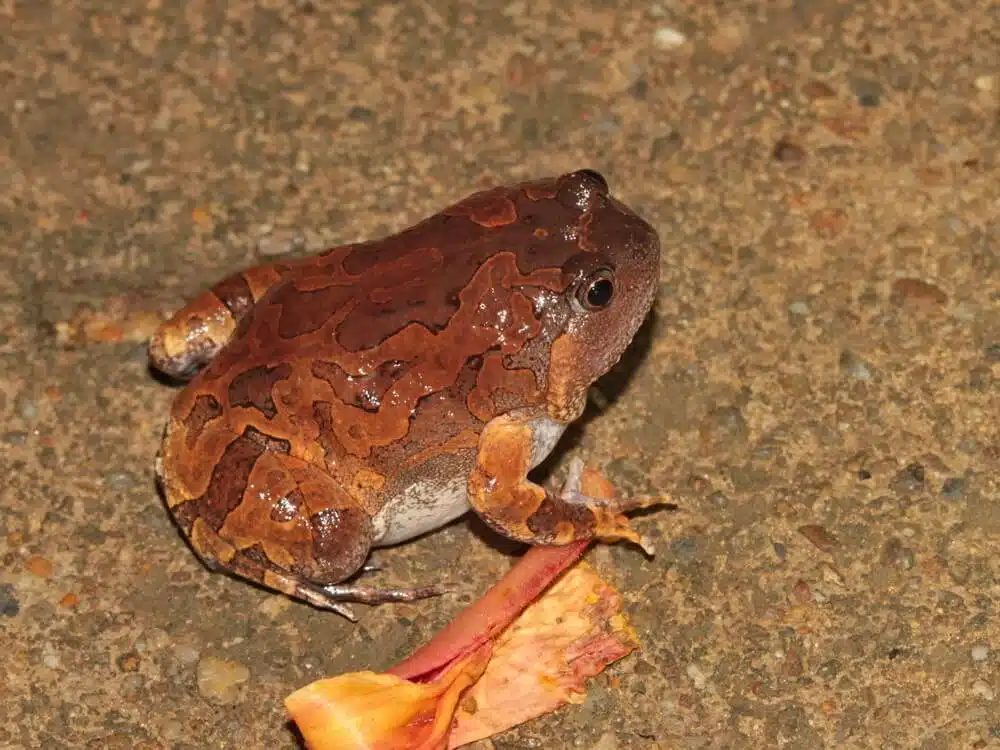
A species found in Burma, Thailand, Vietnam, and other Asian territories, this frog (Glyphoglossus guttulatus) comes in different colors.
Its appearance ranges from an olive-green color to a bright red morph.
The red morph Burmese Squat Frog features a vivid red color with red dorsal stripes that feature thin black borders.
Its dorsal stripes are wavy while the head of the frog is mostly bright gray.
Found at elevations of up to 1.000 feet, The Burmese Squat Frog is only seen in the breeding season and is largely absent afterward.
Red nuance – bright red
9. Reticulated Poison Frog
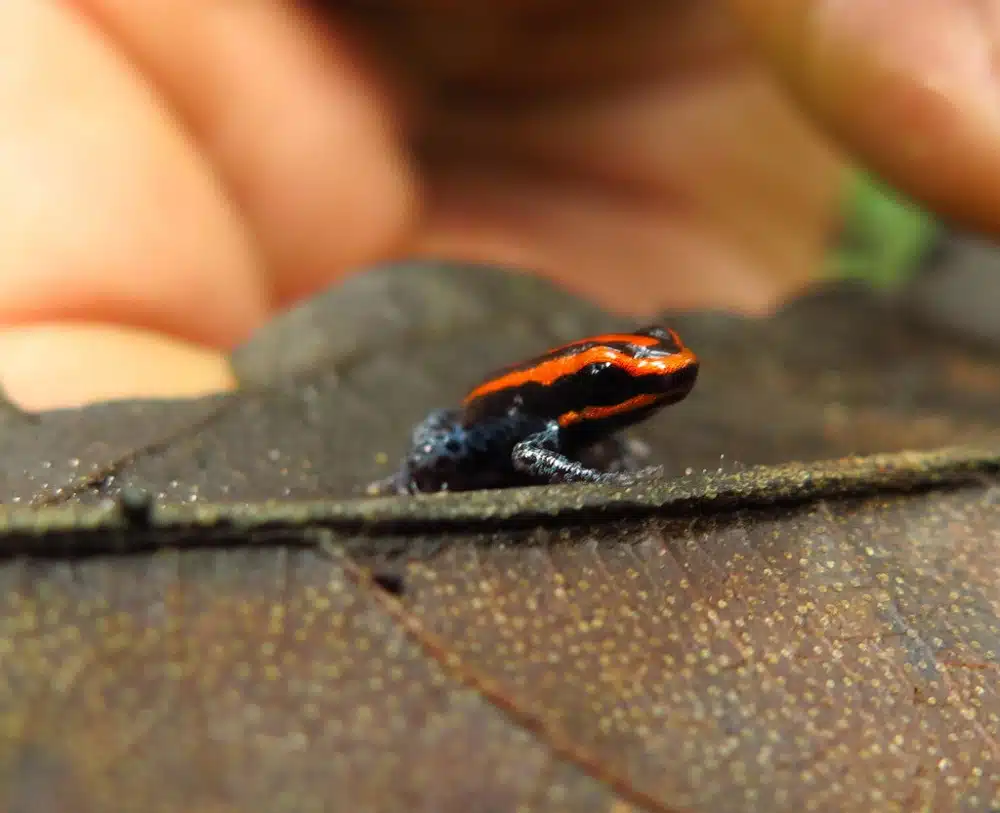
A species that also comes in multiple colors, Reticulated Poison Frogs (Ranitomeya ventrimaculata) can have red stripes on a mainly black dorsum.
These frogs may also have orange and yellow stripes on a black dorsum.
The legs of the species are mostly black, with a pale green or white mesh.
Reticulated Poison Frogs are poisonous to a small extent to humans. Direct contact rarely leads to any serious conditions.
These frogs rely on poison to kill off bacteria that would attach to their skin as well as against predators.
A tropical forest species, The Reticulated Poison Frog is mainly found in South America where it reaches a size of up to 0.8 inches.
Red nuance – bright red
10. Desert Tree Frog
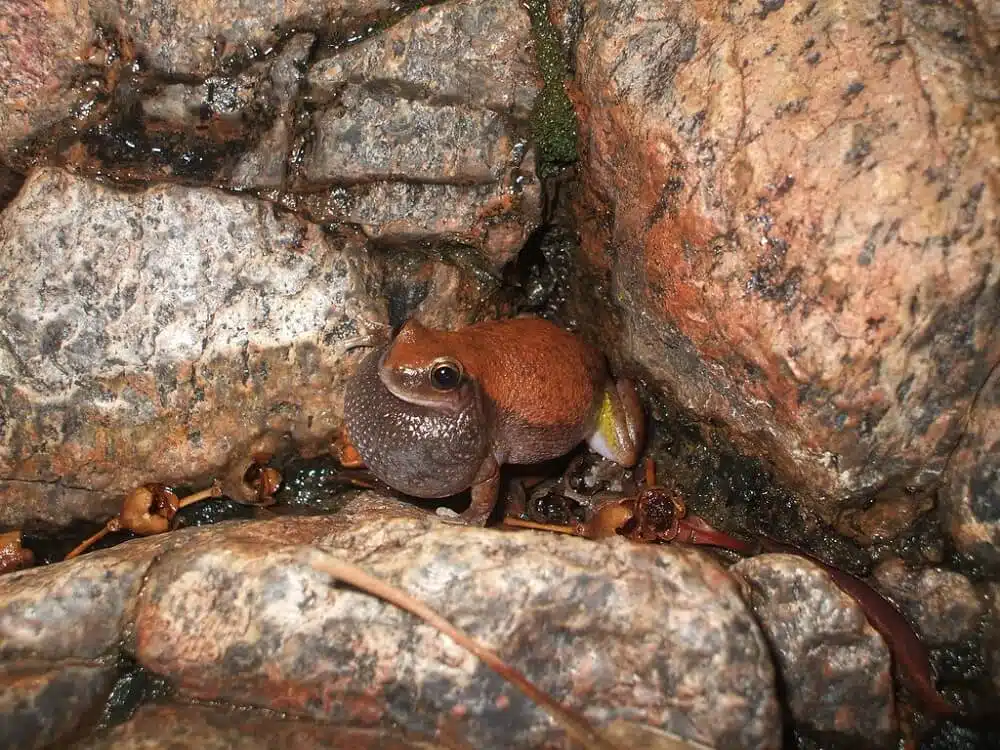
Desert Tree Frogs (Litoria rubella) are a common red frog in Australia. As the name of the species implies, the frog lives in desert climates, mostly in Northern Australia.
This frog comes in a brown-red color which is paler on the underside. A bright gray variant of The Desert Tree Frog also exists.
This is a species that is also slightly patterned across its morphs. Red morph frogs come with darker red dorsal patterns while the gray morph shows dorsal stripes.
A species easy to spot as it doesn’t move underground, The Desert Tree Frog lives in shaded areas of its arid climate.
It only lives in proximity to water in its native range.
Red nuance – brown-red
11. African Red Toad

Found in the Southeastern parts of Africa, this species (Schismaderma carens) is one of the common red toads of sub-Saharan Africa.
It features a brown-red dorsal color or an orange-red morph of the dorsum. Its underside and lateral sides are gray with black spots.
Darker red-brown patches may also contrast its bright dorsal appearance.
African Red Toads grow to a size of over 3 inches and can be found around still water in states such as Congo and South Africa.
Small differences are seen between the sexes as female toads are larger.
Red nuance – brown-red
12. Sheep Frog

Sheep Frogs (Hypopachus variolosus) are one of the variable red-nuance species with a partial presence in The United States.
These frogs may be found in small populations in Texas but live in higher numbers across Mexico and Central America.
From bright to dark red nuances, Sheep Frogs are seen in red-tan to red-brown nuances.
Some of its morphs come with black spots on the lower dorsum or the legs while others can come with a bright orange-red stripe across the mid-dorsum.
The species also shows gray lateral coloring with black spots or black lines.
Red nuances of the species are influenced by the colors of its habitat.
Red nuance – red-tan, red-brown, red-orange
13. Red-Banded Rubber Frog

Mostly black, the Red-banded Rubber Frog (Phrynomantis bifasciatus) has vivid red stripes across its dorsum.
2 red stripes are seen along the sides of its dorsum. These can also be pink or yellow under different morphs.
Additionally, Red-banded Rubber Frogs have matching red spots on the legs and matching yellow or pink spots with their other morphs.
Ventral coloring is bright gray, across the morphs.
Red-Banded Rubber Frog are toxic. They can release a toxic substance through the skin when handled or when in danger.
Red nuance – bright red
14. Little Devil Poison Frog

Found in Colombia and Ecuador, Little Devil Poison Frogs (Oophaga sylvatica) can also be red.
An orange-red nuance with black patterns is specific to this species. The patterns on its back resemble those of its orange morph.
A small frog that grows to a size of at least 1 inch, Little Devil Poison Frogs live in tropical forests.
They are a known poisonous species to both humans and animals and show territorial traits.
Males are more territorial and less likely to move around as females given they like to establish a calling area.
Red nuance – orange-red
15. Peter’s Tree Frog

Growing to an average size of 1.4 inches, Peter’s Tree Frogs (Nyctixalus pictus) are known for their numerous red nuances.
They are seen in red-tan nuances and red-brown nuances. Deep red nuances are also characteristic of the species.
Red colors cover the dorsum and the legs of the species. Small white dots with black margins decorate this frog with warty skin.
The number of white dorsal spots varies. Brighter Peter’s Tree Frogs tend to show extra white spots.
A species native to Indonesia and The Philippines, these types of frogs are arboreal and show a flattened body shape and orang-brown eyes across their morphs.
Red nuance – orange-red, red-brown
16. Anthony’s Poison Arrow Frog

A dark red nuance dominates the appearance of Anthony’s Poison Arrow Frog (Epipedobates anthonyi).
This species shows wide white dorsal stripes and additional decorative white dots on the legs.
White dots are not seen on its back and are only specific to its legs.
Growing to a size of at least 0.7 inches, Anthony’s Poison Arrow Frogs are endemic to Peru and Ecuador.
Its numbers are believed to be diminishing as the species is even largely absent outside of its breeding period.
These types of frogs are diurnal and are part of a larger group of poison dart frogs that live in Central and South America.
Red nuance – bright red
17. Loreto White-lipped Frog
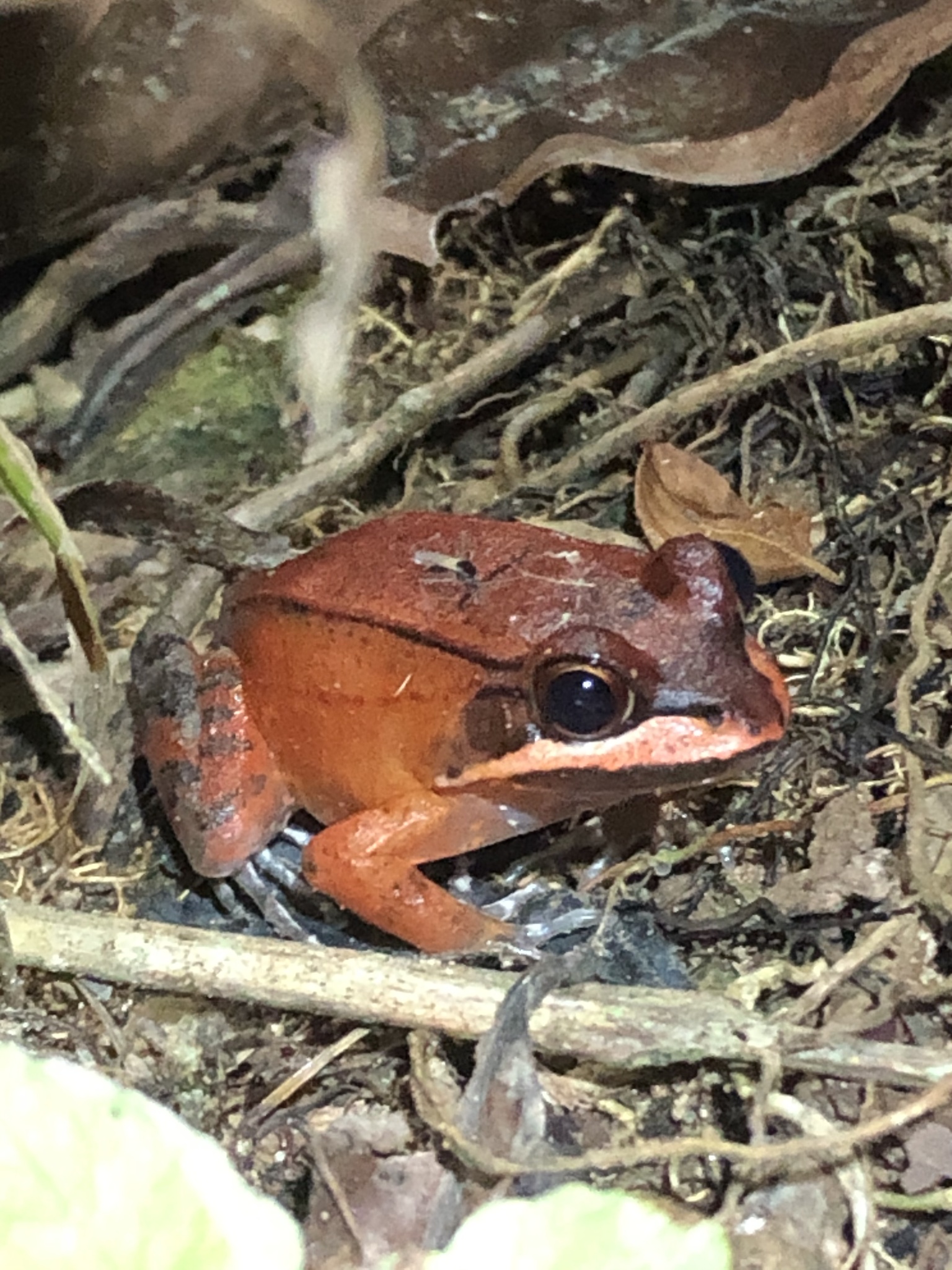
Various shades of red are specific to The Loreto White-lipped Frog (Leptodactylus rhodomystax).
Seen in South America in numerous morphs, this species can be bright red, dark red, red-brown, or red and black.
One of its common dark red morphs shows a black head and black legs.
Living in leaf litter and along tropical forests, this is a species that is also seen in rare green morphs.
Loreto White-lipped Frogs are seen in the Northern parts of South America and deep in The Amazon.
A species that lives in burrows where males call and establish their territory on their own.
Red nuance – bright red, dark red, red-brown
18. Red-backed Toadlet

Red-backed Toadlets (Pseudophryne coriacea) are Australian natives of various morphs. A red morph and an orange morph are specific to the species.
Not entirely red, this is a species with a red dorsum while its ventral side and lateral coloring are gray, black, and red.
A black lateral band separates the red dorsal color from the gray ventral color.
These Eastern Australian frogs also show additional white decorative spots. These white spots are only seen on the gray sections of the frog.
Brown morphs of the species may even have uniform gray legs.
Some Red-backed Toadlets also show a mostly red color with a sole black lateral stripe.
Red nuance – bright red, red-brown
19. Andean Poison Frog
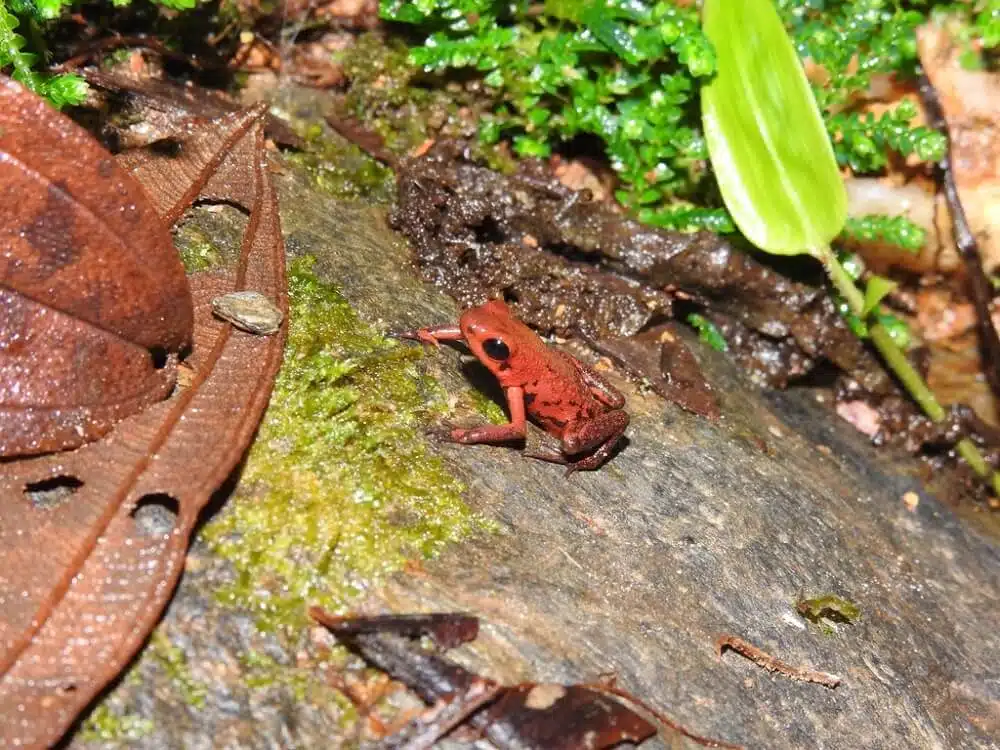
A Colombian native, Andean Poison Frogs (Andinobates opisthomelas) are often spotted in a uniform red color.
This red color is bright, making the species look highly poisonous to its predators. Other morphs also exist.
Large black eyes are one of the few common traits across the various Andean Poison Frog morphs.
A red and dark brown morph is also common. The lower part of the body is dark brown while the upper part is vivid red.
This morph also shows 2 contrasting black dots on the lateral sides of its upper back.
Red nuance – bright red
20. Red Narrow Mouthed Frog

Red-brown or brown nuances are specific to The Red Narrow Mouthed Frog (Microhyla rubra).
This is a species with a dark red dorsum coupled with a white or gray ventral appearance.
Dark gray and even black lateral coloring is specific to the species both in its red-brown and brown morphs.
Black or dark gray spots may be seen on its legs in both morphs.
Long believed to be a subspecies of frogs, Red Narrow Mouthed Frogs are now recognized as distinct Indian frogs.
This species lives in temporary bodies of water around the subcontinent.
Red nuance – red-brown
21. Golden Mantella

Golden Mantellas (Mantella aurantiaca) are named after their common golden-yellow color but they also come in a red morph.
This species grows to a size of up to 1 inch and also comes in bright red nuances.
Its eyes are large and black, contrasting its bright appearance.
These types of colorful frogs are Madagascar native. A diurnal species, these frogs are poisonous.
A small number of predators, particularly snakes, are known to be among the few animals which are immune to the poison of Golden Mantellas.
Red nuance – bright red
22. West African Rubber Frog
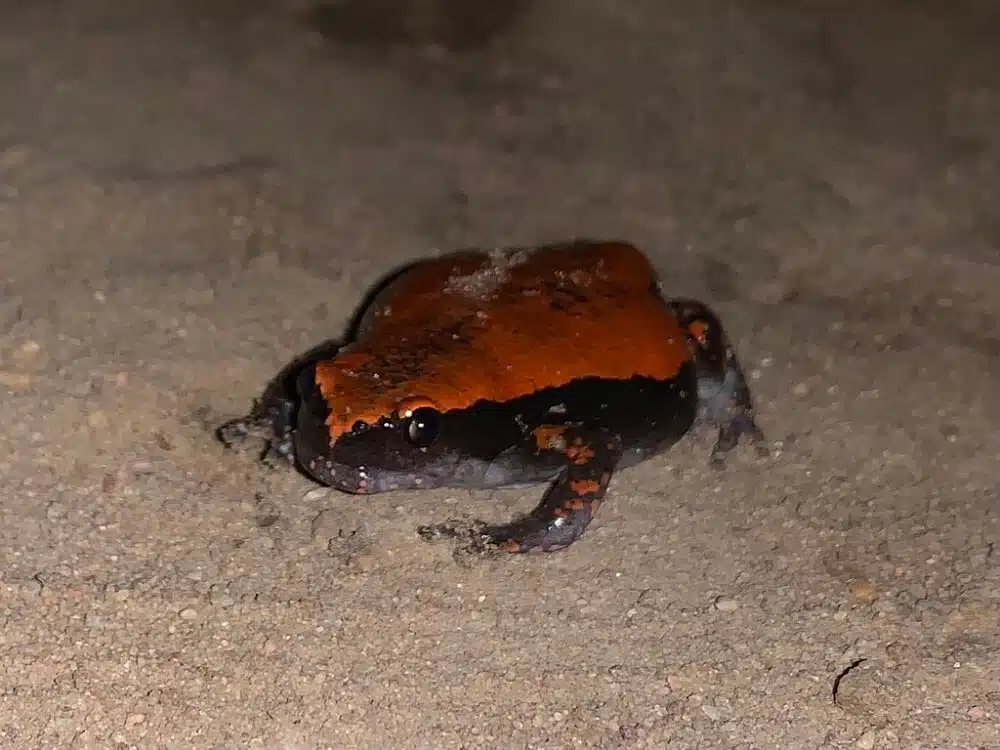
A red-brown nuance is specific to the dorsum of West African Rubber Frogs (Phrynomantis microps).
Black margins and black patterns are seen across the legs of the species.
These types of frogs have atypical living habits and eating habits. They live in mounds as they show immunity when stung by ants.
These frogs also eat stinging ants as well as termites.
However, West African Rubber Frogs are nocturnal and come out at night for ants and termites.
They never eat the ants of the mount they choose to live in.
Red nuance – red-brown
23. Ecuador Poison Frog

A species of Ecuador and Northern South America, Ecuador Poison frogs (Ameerega bilinguis) have vivid red dorsal coloring.
Their warty skin shows uniform red coloring on the back. Additional colors include gray, olive, black, and yellow.
These additional colors are seen on the legs and their sides.
Yellow dots further signal a potentially-poisonous status to its predators.
Some of the rare morphs of The Ecuador Poison Frog include a red-brown back with bright blue sides which also show additional yellow spots.
Red nuance – dark red, red-brown
24. Tolima Poison Frog
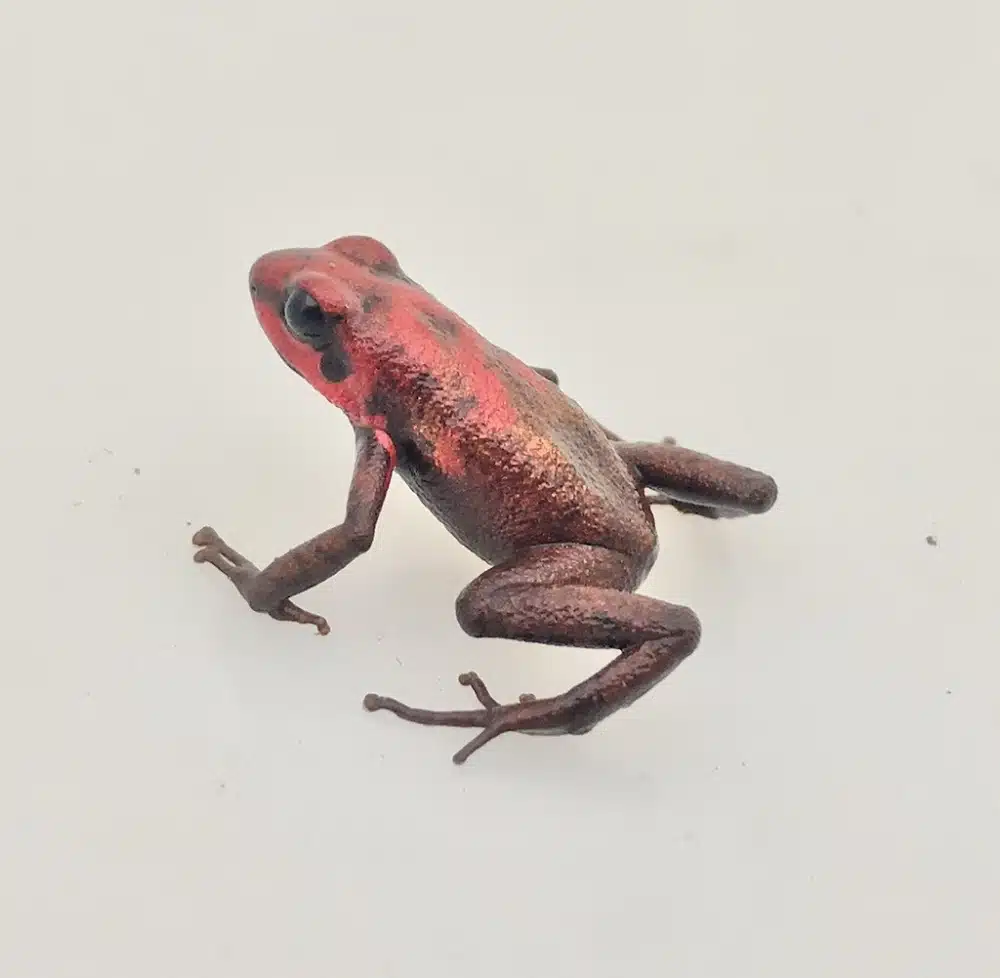
Tolima Poison Frogs (Andinobates dorisswansonae) have a base black color contrasted by red patterns.
A pattern of red spots covers the body and limbs of Tolima Poison Frogs, a species-specific to tropical climates.
These contrasting black and red frogs are seen on the leaves of various fruit trees. This is also where they lay eggs before moving them to a water source.
Handling these frogs isn’t recommended as their skin secretions produce a toxic poison. Some of the reactions to touching the frog include itching and swollen skin.
Red nuance – bright red
25. Red Pumpkin Toadlet

These types of toadlets (Brachycephalus pitanga) are found at higher elevations in South American rainforests.
A base orange color is specific to this species which further shows large red spots across the dorsum.
This is also a species that has a varying number of red dorsal spots. Its red marks on the back may also come in different shapes and sizes.
A diurnal species often spotted on the ground in leaf litter, this frog is small, reaching a size of up to 0.5 inches.
It’s considered toxic to humans.
Red nuance – pale red, orange-red
26. Splashback Poison Frog

Named after the colorful patterns on its back, Splashback Poison Frogs (Adelphobates galactonotus) are common in captivity.
These frogs are native to The Amazon Rainforest where they are seen in stable populations.
High color variation is characteristic of the species. It can come in a yellow back or red back morph.
Its red morph has a mostly red back color while its yellow variants can be plain or spotted.
Its legs and ventral side are black.
A species that lives on the ground among leaf litter, Splashback Poison Frogs are toxic and may grow to a size of up to 1.7 inches.
Red nuance – orange-red